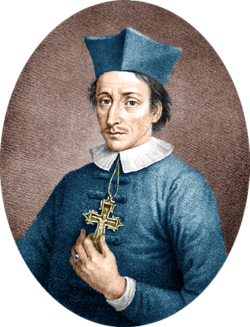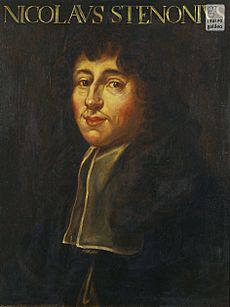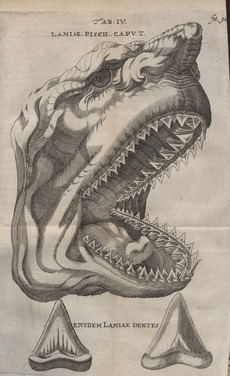Nicolas Steno facts for kids
Quick facts for kids Blessed Niels Steensen |
|
|---|---|
| Vicar Apostolic of Nordic Missions | |

Portrait of Steno as bishop (1868)
|
|
| See | Titiopolis |
| Appointed | 21 August 1677 by Pope Innocent XI |
| Reign ended | 5 December 1686 |
| Predecessor | Valerio Maccioni |
| Successor | Friedrich von Tietzen |
| Other posts | Titular Bishop of Titiopolis |
| Orders | |
| Ordination | 13 April 1675 |
| Consecration | 19 September 1677 by Saint Gregorio Barbarigo |
| Personal details | |
| Birth name | Niels Steensen |
| Born | 1 January 1638 [NS: 11 January 1638] Copenhagen, Denmark-Norway |
| Died | 25 November 1686 (aged 48) [NS: 5 December 1686] Schwerin, Duchy of Mecklenburg-Schwerin |
| Buried | Basilica of San Lorenzo, Italy |
| Nationality | Danish |
| Denomination | Roman Catholic |
| Parents |
|
| Occupation |
|
| Previous post |
|
| Coat of arms |  |
| Sainthood | |
| Feast day | 5 December |
| Venerated in | Roman Catholic Church |
| Beatified | 23 October 1988 Rome, Vatican City by Pope John Paul II |
Niels Steensen (also known as Nicolaus Steno) was a Danish scientist. He was a pioneer in both anatomy (the study of body structures) and geology (the study of Earth's rocks and history). Later in his life, he became a Catholic bishop. He was born on January 1, 1638, and passed away on November 25, 1686.
Niels Steensen studied old science books. But by 1659, he started to question what was commonly believed about the natural world. He wondered about how tears were made, if fossils really grew in the ground, and how rocks formed. His studies on fossils and rocks led experts to see him as one of the founders of modern stratigraphy (the study of rock layers) and modern geology.
Steensen was born into a Lutheran family. In 1667, he became a Catholic. After this, his interest in science lessened, and he became more interested in religion. In 1675, he decided to become a priest. He was ordained (made a priest) on Easter Sunday that year. Later, Pope Innocent XI made him a bishop for missions in Northern Germany. Steensen played a big part in the Counter-Reformation, which was the Catholic Church's effort to reform itself and respond to the Protestant Reformation.
His process to become a saint began in 1938. Pope John Paul II declared him "Blessed" in 1988.
Contents
Early Life and Studies
Niels Steensen was born in Copenhagen, Denmark, on January 1, 1638. His father was a goldsmith who worked for the king. When Niels was three, he got sick with an unknown illness and spent much of his childhood alone. His father died in 1644. In 1654–1655, many students at his school died from the plague.
At 19, Steensen started studying medicine at the University of Copenhagen. After finishing his studies, he traveled a lot around Europe. He met many important doctors and scientists in the Netherlands, France, Italy, and Germany. These meetings helped him learn to observe things carefully and make his own scientific discoveries.
Steensen first went to Rostock, then to Amsterdam. There, he studied anatomy with Gerard Blasius. He focused on the lymphatic system (which helps the body fight disease). After a few months, Steensen moved to Leiden. He met other famous students and professors there, including Baruch Spinoza. Steensen disagreed with René Descartes' idea that tears came from the brain.
He was invited to Paris, where he met people interested in his new research. In 1665, Steensen traveled to other cities in France. His work was introduced to the Royal Society in England.
In 1666, he moved to Italy. He became a professor of anatomy at the University of Padua. Then he worked in Florence as a doctor for Grand Duke Ferdinando II de' Medici. The Duke supported arts and science. Steensen was asked to collect interesting objects for a "cabinet of curiosities." He also visited Rome and met Pope Alexander VII.
Amazing Scientific Discoveries
Anatomy Discoveries
While in Amsterdam, Steensen found a new structure in the heads of sheep, dogs, and rabbits. This was the "ductus Stenonis," now called the Stensen's duct. It is part of the parotid salivary gland. There was a disagreement about who discovered it first, but Steensen's name stuck.
In Leiden, Steensen studied a boiled cow's heart. He realized it was just an ordinary muscle. This was different from what ancient thinkers like Galen and Descartes believed. They thought the heart was the center of warmth.
In Florence, Steensen studied the muscular system and how muscles contract. He joined a science group called Accademia del Cimento. He showed that a contracting muscle changes its shape but not its volume (how much space it takes up). Steensen was also the first to describe the lateral line system in fish, which helps them sense movement in water.
Paleontology Insights
In October 1666, fishermen caught a huge female shark near Livorno, Italy. The Grand Duke of Tuscany asked Steensen to examine its head. Steensen cut open the shark's head and wrote about what he found in 1667.
He noticed that the shark's teeth looked very much like certain stony objects. These objects were found inside rocks and were called glossopetrae or "tongue stones." Ancient writers thought these stones fell from the sky or the Moon. Others believed that fossils grew naturally inside rocks.
Steensen's work on shark teeth made him wonder how any solid object could be found inside another solid object, like a rock. The "solid bodies within solids" he studied included fossils, minerals, crystals, and even whole layers of rock. He published his geology studies in a book called Preliminary discourse to a dissertation on a solid body naturally contained within a solid in 1669. This was his last major scientific work.
Geology and Rock Layers
In his 1669 book, Steensen described four key ideas for the science of stratigraphy, which is the study of rock layers. These ideas are still used today:
- The Law of Superposition: This means that in layers of rock, the oldest layers are at the bottom, and the newest layers are at the top. It's like stacking books – the first book you put down is at the bottom.
- The Principle of Original Horizontality: This states that rock layers are usually formed in flat, horizontal sheets. If you see them tilted or folded, it means something happened to them after they formed.
- The Principle of Lateral Continuity: This means that rock layers extend sideways in all directions until they thin out or hit a barrier. So, if you see a rock layer on one side of a valley, it probably continues on the other side.
- The Principle of Cross-Cutting Relationships: If something like a crack or a different rock formation cuts across a rock layer, then the thing that cuts across must be younger than the layer it cuts.
These ideas were very important for the development of geology. They helped scientists like James Hutton understand how Earth's surface changes over long periods.
Crystal Study
Steensen also made important observations about crystals in his 1669 book. He discovered a rule in crystallography (the study of crystals) called Steensen's law. This law says that the angles between the same faces on crystals are always the same for all samples of the same mineral. This discovery was a big step forward and helped later scientists understand crystal structure.
Religious Journey
Steensen's curious mind also led him to question his religious beliefs. He grew up in the Lutheran faith. But when he was studying in Florence, he learned about Roman Catholicism. He compared the two faiths and decided that Catholicism offered more answers to his questions. In 1667, Steensen became a Catholic.
In 1671, he became a professor of anatomy at the University of Copenhagen. However, he promised the Grand Duke of Tuscany that he would return to Italy.
In 1675, Steensen decided to become a priest. He was ordained on April 13, 1675, in Florence. He was 37 years old. Steensen then focused on religious studies and became a key figure in the Counter-Reformation. In 1677, Pope Innocent XI made him a bishop for the Nordic Missions. He moved to the Lutheran North of Germany.
As a bishop, he worked in Hanover until 1680. He even had discussions with the famous philosopher Gottfried Leibniz. In 1680, he became an auxiliary bishop in Münster. He continued his work to promote Catholicism.
In 1683, Steensen resigned as auxiliary bishop after a disagreement. He moved to Hamburg in 1684. There, he studied the brain and nervous system again with an old friend. Later, he moved to Schwerin. Steensen lived very simply, often eating only bread and beer. He became very thin.
After completing his difficult missions, he wanted to return to Italy. But he became very ill and died in Germany on November 25, 1686. His body was sent to Florence, as requested by the Grand Duke. He was buried in the Basilica of San Lorenzo. In 1946, his grave was opened, and his body was reburied after a procession.
Becoming Blessed
After his death, people in the diocese of Hildesheim honored Steensen as a saint. His good deeds and strong faith were studied for a possible canonization (being declared a saint). This process began in 1938. In 1953, his grave was opened as part of the process. His body was moved to an old Christian coffin. He was declared "Blessed" by Pope John Paul II in 1988. His feast day is December 5.
Legacy
Niels Steensen's life and work are still studied today, especially his contributions to geology.
- The Steensen Museum in Aarhus, Denmark, is named after him. It has exhibits on the history of science and medicine.
- The Steno Medal is given to important geologists in Denmark and Greenland. It is named in his honor.
- There are craters on Mars and the Moon named after him.
- The mineral Stenonite is named in his honor.
- A Catholic church in Grevesmühlen, Germany, is dedicated to Niels Steensen.
- The "Niels Steensens Gymnasium," a Catholic school in Copenhagen, was founded in 1950.
- The Steno Diabetes Center, a hospital for diabetes research and teaching in Denmark, is named after him.
- The Istituto Niels Stensen was founded in Florence, Italy, in 1964.
- On January 11, 2012, Steensen was honored with a Google Doodle as the founder of geology.
Major Works
- Steensen, Niels / Sténon, Niels. Nicolai Stenonis Observationes anatomicae..., (1662)
- Steensen, Niels /Steensen, Niels. Nicolai Stenonis De Musculis et glandulis observationum specimen..., (1664).
- Nicolai Steensennis Elementorum Myologiae Specimen..., (1667)
- Discours de M. Stenon sur l'anatomie du cerveau..., (1669)
- Nicolai Stenonis solido intra solidum naturaliter contento dissertationis prodromus ... (1669), via Google Books The Prodromus of Nicolaus Steno's Dissertation concerning a solid body enclosed by process of nature within a solid; an English version with an introduction and explanatory notes by John Garrett Winter, New York: Macmillan Company, (1916)
- Nicolai Stenonis ad novae philosophiae reformatorem de vera philosophia epistola, Florentiae, 1675 (letter to Spinoza)
- Nicolai Stenonis Opera philosophica, edited by Wilhelm Maar... vol. I, Copenhagen : V. Tryde, (1910)
- Nicolai Stenonis Opera philosophica, edited by Wilhelm Maar... vol. II, Copenhagen : V. Tryde, (1910)
See also
 In Spanish: Nicolás Steno para niños
In Spanish: Nicolás Steno para niños




